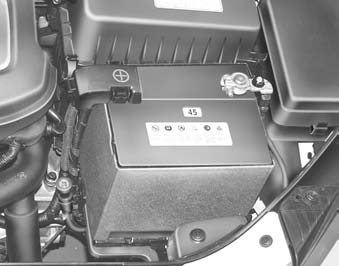Battery
WARNING - Battery
dangers
Always read the following
instructions carefully when
handling a battery.
Keep lighted cigarettes and all other flames or sparks away from the battery.
Hydrogen, which is a highly combustible gas, is always present in battery cells and may explode if ignited.
Keep batteries out of the reach of children because batteries contain highly corrosive SULFURIC ACID.
Do not allow battery acid to contact your skin, eyes, clothing or paint finish.
If any electrolyte gets into
your eyes, flush your eyes
with clean water for at least
15 minutes and get immediate
medical attention. If
possible, continue to apply
water with a sponge or
cloth until medical attention
is received.
If electrolyte gets on your skin, thoroughly wash the contacted area. If you feel a pain or a burning sensation, get medical attention immediately.
Wear eye protection when
charging or working near a
battery. Always provide
ventilation when working in
an enclosed space.
An inappropriately disposed
battery can be harmful
to the environment and
human health. Dispose the
battery according to your
local law(s) or regulation.
• When lifting a plastic-cased battery, excessive pressure on the case may cause battery acid to leak, resulting in personal injury.
Lift with a battery carrier or with your hands on opposite corners.
• Never attempt to charge the battery when the battery cables are connected.
• The electrical ignition system works with high voltage. Never touch these components with the engine running or the ignition switched on.
Failure to follow the above warnings can result in serious bodily injury or death.

For best battery service : • Keep the battery securely mounted.
• Keep the top of the battery clean and dry.
• Keep the terminals and connections clean, tight, and coated with petroleum jelly or terminal grease.
• Rinse any spilled electrolyte from the battery immediately with a solution of water and baking soda.
• If the vehicle is not going to be used for an extended time, disconnect the battery cables.
Battery recharging
Your vehicle has a maintenance-free,
calcium-based battery.
• If the battery becomes discharged in a short time (because, for example, the headlights or interior lights were left on while the vehicle was not in use), recharge it by slow charging (trickle) for 10 hours.
• If the battery gradually discharges because of high electric load while the vehicle is being used, recharge it at 20- 30A for two hours.
Items to be reset after the battery has been discharged or the battery has been disconnected.
• Clock (See Chapter 3)
• Audio (See Chapter 3)
• Sunroof (See Chapter 3)
WARNING - Recharging
battery
When recharging the battery,
observe the following precautions:
• The battery must be removed
from the vehicle and placed in an
area with good ventilation.
• Do not allow cigarettes, sparks, or flame near the battery.
• Watch the battery during charging, and stop or reduce the charging rate if the battery cells begin gassing (boiling) violently or if the temperature of the electrolyte of any cell exceeds 49°C (120°F).
• Wear eye protection when checking the battery during charging.
• Disconnect the battery charger in the following order.
1. Turn off the battery charger main switch.
2. Unhook the negative clamp from the negative battery terminal.
3. Unhook the positive clamp from the positive battery terminal.
NOTICE
• Before performing maintenance or
recharging the battery, turn off all
accessories and stop the engine.
• The negative battery cable must be removed first and installed last when the battery is disconnected.
See also:
Safety features of your vehicle
Seats
Seat belts
Child restraint system
Air bag - advanced supplemental restraint system ...
Climate control air filter
Filter inspection
The climate control air filter should be
replaced according to the maintenance
schedule. If the vehicle is operated in
severely air-polluted cities or on dusty
rough roads for a ...
Label information
Vehicle identification number
(VIN)
The vehicle identification number (VIN) is
the number used in registering your car
and in all legal matters pertaining to its
ownership, etc.
It can be foun ...


